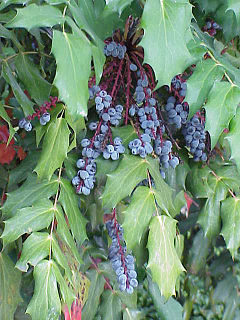
Mahonia is a genus of approximately 70 species of evergreen shrubs and, rarely, small trees in the family Berberidaceae, native to eastern Asia, the Himalaya, North and Central America. They are closely related to the genus Berberis and botanists disagree on whether to recognize a separate Mahonia. Many botanists prefer to classify Mahonia as a part of Berberis because several species in both genera are able to hybridize, and because there are no consistent morphological differences between the two groups other than the leaf pinnation. However, recent DNA-based phylogenetic studies retain the two separate genera, by clarifying that unifoliolate-leaved Berberis s.s. is derived from within a paraphyletic group of shrubs bearing imparipinnate evergreen leaves, which are then divided into three genera: Mahonia, Alloberberis, and Moranothamnus ; a broadly-circumscribed Berberis would also be monophyletic.
The Association for Relations Across the Taiwan Straits is an organization set up by the People's Republic of China for handling technical or business matters with the Republic of China (Taiwan).

Berberis, commonly known as barberry, is a large genus of deciduous and evergreen shrubs from 1–5 m (3.3–16.4 ft) tall, found throughout temperate and subtropical regions of the world. Species diversity is greatest in South America and Asia; Europe, Africa and North America have native species as well. The best-known Berberis species is the European barberry, Berberis vulgaris, which is common in Europe, North Africa, the Middle East, and central Asia, and has been widely introduced in North America. Many of the species have spines on the shoots and all along the margins of the leaves.

The Berberidaceae are a family of 18 genera of flowering plants commonly called the barberry family. This family is in the order Ranunculales. The family contains about 700 known species, of which the majority are in Berberis. The species include trees, shrubs and perennial herbaceous plants.

Lung Ying-tai is a Taiwanese essayist and cultural critic. She occasionally writes under the pen name 'Hu Meili'. Lung's poignant and critical essays contributed to the democratization of Taiwan and as the only Taiwanese writer with a column in major mainland Chinese newspapers, she is an influential writer in Mainland China. She has written 17 books.

Berberis microphylla, common name box-leaved barberry and Magellan barberry, in Spanish calafate and michay and other names, is an evergreen shrub, with simple, shiny box-like leaves. The calafate is native to southern Argentina and Chile and is a symbol of Patagonia.

Berberis vulgaris, also known as common barberry, European barberry or simply barberry, is a shrub in the genus Berberis. It produces edible but sharply acidic berries, which people in many countries eat as a tart and refreshing fruit.

Berberis thunbergii, the Japanese barberry, Thunberg's barberry, or red barberry, is a species of flowering plant in the barberry family Berberidaceae, native to Japan and eastern Asia, though widely naturalized in China and North America. Growing to 1 m (3.3 ft) tall by 2.5 m (8.2 ft) broad, it is a small deciduous shrub with green leaves turning red in the autumn, brilliant red fruits in autumn and pale yellow flowers in spring. Numerous cultivars are available as ornamental plants suitable for hedging.

The Chinese Taipei women's national football team is the international women's football team for the Republic of China.
Yang Ying is a Chinese table tennis player, born 13 July 1977 in Xuzhou, Jiangsu Province. She achieved gold medals at several World Table Tennis Championships in either doubles or team play. She played right-handed Chinese penhold style. Her main techniques were forehand and backhand speed drives. Since 2008 Yang has been working as a table tennis commentator for CCTV-5.

Berberine is a quaternary ammonium salt from the protoberberine group of benzylisoquinoline alkaloids found in such plants as Berberis, such as Berberis vulgaris (barberry), Berberis aristata, Mahonia aquifolium, Hydrastis canadensis (goldenseal), Xanthorhiza simplicissima (yellowroot), Phellodendron amurense, Coptis chinensis, Tinospora cordifolia, Argemone mexicana, and Eschscholzia californica. Berberine is usually found in the roots, rhizomes, stems, and bark.
Mahonia microphylla is a shrub in the Berberidaceae first described as a species in 1999. It is endemic to Guangxi Province in China.

Dr Law Kar-yingBBSMH is a Hong Kong opera singer and actor.
Ying Shao (140-206), courtesy name Zhongyuan, was a Chinese politician, writer and historian who lived during the Eastern Han dynasty. He was an author of the Fengsu Tongyi, an encyclopedic work about the folk customs and legends that existed in the Eastern Han dynasty. Ying Shao occupied official posts in the Han government, and in his official position he was an active participant in imperial politics. He was a long-time close associate of Cao Cao, and in that connection he was extensively covered in volumes 9, 35, 71 and 103 of the historical text Book of the Later Han.

The Ying River is the largest tributary of the Huai River with its origin in Henan Province, People's Republic of China. From Zhoukou City in Henan the river flows through Fuyang City in Anhui Province then empties into the Huai River at Zhengyang.

Berberis julianae, the wintergreen barberry or Chinese barberry, is a flowering evergreen shrub native to Central China. It is widely grown as an ornamental in other temperate regions. It is reportedly naturalized in scattered parts of the United States.
Berberis amabilis is a shrub native to Yunnan and Myanmar (Burma). It grows at elevations of 1800–3300 m.

Berberis bealei, also known as leatherleaf mahonia, Beale's barberry, or Oregon grape, is a species of evergreen shrub native to mainland China. The species has been regarded as the same species as Berberis japonica, native to Taiwan, but the two differ consistently in certain floral and leaf characters. Both species are widely cultivated in many countries as ornamentals. Berberis bealei has reportedly escaped cultivation and become established in the wild in scattered places in the south-eastern United States from Arkansas to Florida to Delaware.
Berberis haoi is a species of flowering plant in the family Berberidaceae, first described in 1999. It is endemic to Gansu Province in northwestern China.
Mahonia retinervis is a shrub in the family Berberidaceae described as a species in 1985. It is endemic to China in the Guangxi and Yunnan Provinces.











